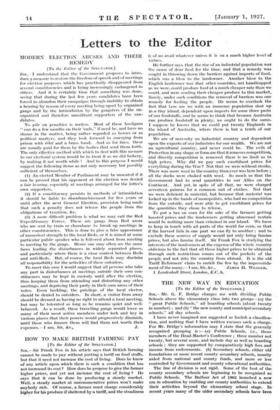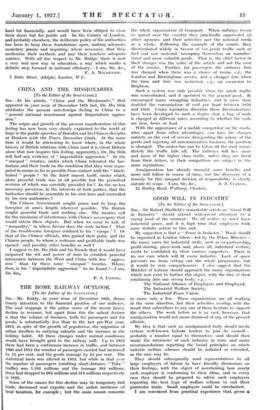THE NEW WAY IN EDUCATION
[To the Editor of the SPECTATOR.] SIR,—Mr. G. F. Bridge charges me with dividing Public Schools above the elementary class into two groups—(a) the " great Public Schools," all boarding schools (about twenty in number) ; and (b)" the new county and municipal secondary schools," all day schools.
I have never imagined nor suggested so foolish a classifica- tion, and nothing that I have written excuses such a charge. For Mr. Bridge's information may I state that the generally recognized grouping is :—(a) Public Schools, i.e., those members of the Head-Master's Conference ; these number not twenty, but several score, and include day as well as boarding schools ; they are supported by comparatively high fees and income from endowments. (b) Secondary schools, either old foundations or more recent county secondary schools, usually aided from national and county funds, and more or less controlled by Government and county educational authorities.
The line of division is not rigid. Some of the best of the county secondary schools are beginning to be recognized as Public Schools. The Balfour Act of 1902 launched a new era in education by enabling our county authorities to extend their activities beyond the elementary school stage. In recent years many of the older secondary schools have been hard hit financially, and would have been obliged to close their doors but for public aid. In the County of London, and probably elsewhere, the deliberate policy of the authorities has been to keep these foundations open, making adequate monetary grants and requiring, where necessary, that they modernize their methods and pay their teachers adequate salaries. With all due respect to Mr. Bridge, there is now a very real new way in education, a way which marks a definite step forward in national efficiency.—I am, Sir, &c., F. A. MACKENZIE. 7 Duke Street, Ade1phi, London, W.C.



































 Previous page
Previous page